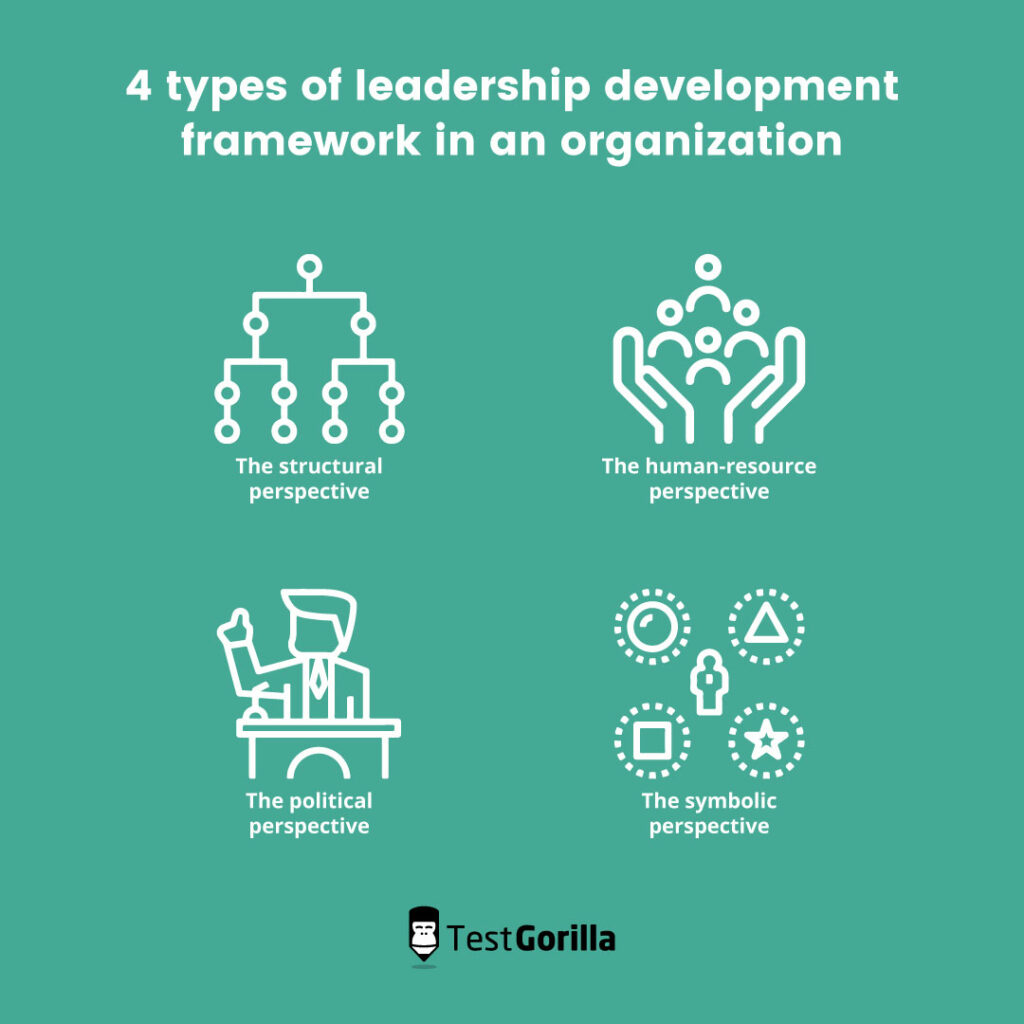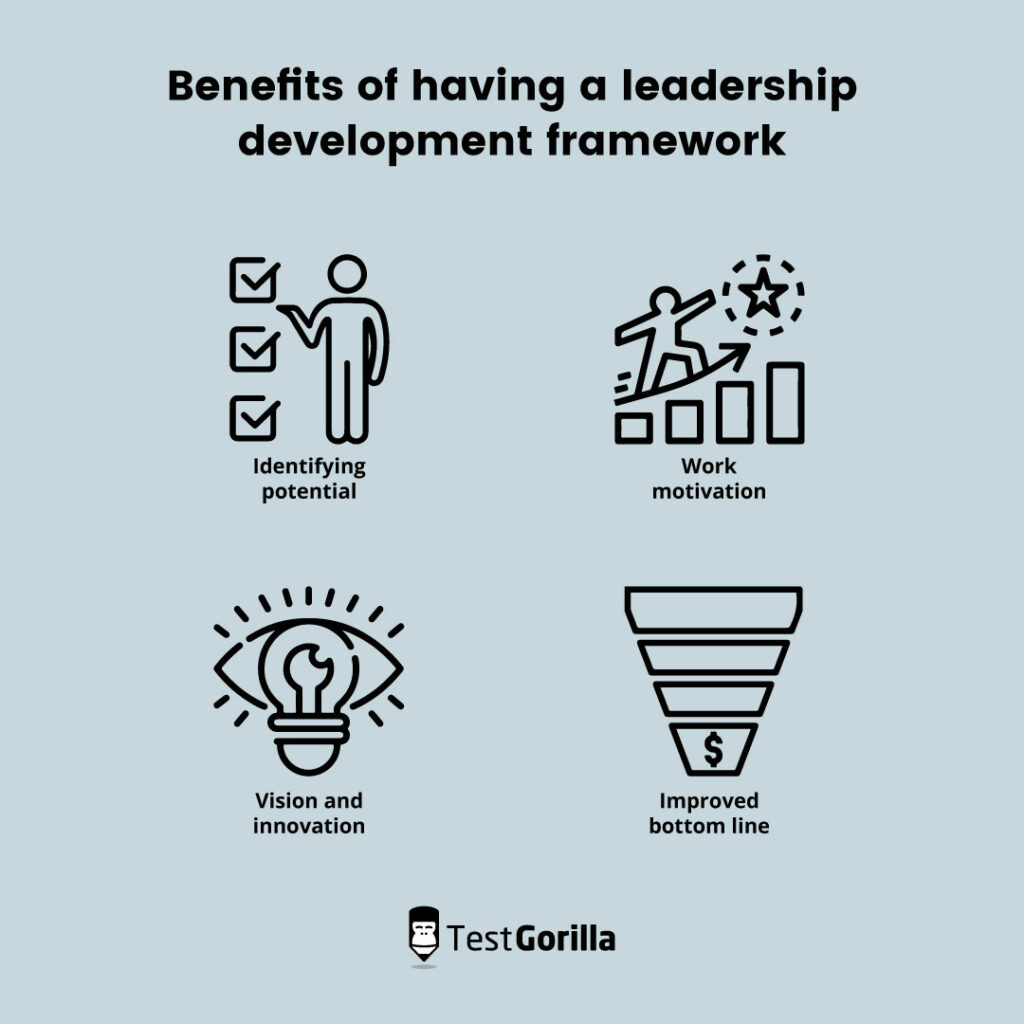How a leadership development framework benefits you and your employees
Leadership development is crucial for any company looking to improve performance and stay competitive in today’s business climate. A good leadership development framework can provide a clear roadmap for building leadership skills at all levels.
From improving communication and teamwork to enhancing decision-making and strategic thinking, a leadership development framework can help individuals become more effective and drive positive change in your organization.
In this article, we’ll explore what a leadership development framework is and how it can benefit your business.
We’ll also provide steps to plan a practical framework for your organization and explain how our Leadership and People Management test can identify promising candidates and employees with exceptional leadership skills.
What is a leadership development framework?
A leadership development framework is a set of guidelines and practices companies use to build leadership qualities in the organization. It includes training, mentoring, coaching, and other opportunities for leaders to gain experience and new skills.
Furthermore, it aims to create a culture of continuous learning and improvement. This enables leaders to develop the skills and knowledge needed to manage their teams and organizations effectively.
According to a report by Deloitte, 80% of companies now understand the importance of having leadership development opportunities, with 41% believing they already have the qualities to meet their needs.
Having a leadership development framework in your organization is critical to success in today’s world. A carefully planned framework will help your business attract and retain top talent, improve performance, and increase employee engagement.
4 types of leadership development framework in an organization
Influential leaders have the ability to inspire and guide their teams toward achieving common goals within the organization.
In their book, Reframing Organizations: Artistry, Choice, and Leadership, Lee Bolman and Terrence Deal proposed four perspectives for understanding leadership development:
Structural
Human resource
Political
Symbolic
The structural perspective
The structural perspective focuses on leadership’s formal and organizational aspects, such as design, systems, and processes. It emphasizes the importance of aligning the structure of an organization with its goals and objectives.
In this perspective, excellent leaders can design and implement effective systems and processes that will support your organization’s success.
The human-resource perspective
This perspective focuses on individuals within the organization and the relationships between them.
This enables effective leaders to foster a positive and supportive work environment that enhances collaboration, creativity, and innovation. They also have the ability to attract, develop, and retain talented employees.
The political perspective
The political perspective focuses on the power dynamics within an organization. Effective leaders can navigate complex relationships and interests within the business, and use this knowledge to advance your organization’s goals.
They also have the ability to build coalitions and manage conflicts. As a result, this framework can be a valuable tool for leaders at all levels of an organization, from entry-level managers to senior executives.
The symbolic perspective
This perspective focuses on the meaning and culture of an organization. Effective leaders should be able to create a vision and a sense of purpose that inspires and guides the organization.
They also have the ability to shape a company’s culture, values, and identity.
By understanding and using these four perspectives, leaders can develop a universal and well-rounded approach.
The best insights on HR and recruitment, delivered to your inbox.
Biweekly updates. No spam. Unsubscribe any time.
Benefits of having a leadership development framework
A good leadership development framework will help ensure your company has a strong team to drive success. Below are the major benefits it offers for employers, hiring managers, and employees:
1. Identifying potential
Firstly, it provides a clear and consistent way to identify and assess leadership skills within the organization. This helps create a solid and capable leadership structure for the future.
2. Work motivation
According to a Gallup survey, motivated teams can help increase a business’s profitability by 21%. Using a leadership development framework can help to create a more engaged and motivated workforce.
When employees see that your company invests in their development and growth, they will feel valued and committed to contribute to the organization’s success.
3. Vision and innovation
Effective leadership development frameworks will also help improve the overall performance of your organization. Smart leaders are essential for driving innovation, creating a solid vision, and leading change.
Leaders with good training and access to good equipment and facilities can drive the organization forward, leading to improved performance and success.
4. Improved bottom line
A leadership development framework can also help to improve your company’s bottom line. Effective leaders make better strategic decisions and drive business results, leading to increased efficiency, improved customer satisfaction, and higher revenues.
How to plan an effective leadership development framework
Planning a practical leadership development framework is essential for any organization that wants to nurture and retain strong leaders. Here are some critical steps to consider when planning your leadership development framework:
1. Identify your organization’s leadership needs
The first step in planning a good framework is to identify the specific leadership needs of your organization. This includes understanding the current and future leadership requirements and identifying any gaps in your leadership team.
2. Assess your current leaders
Assess the current leaders within your organization to identify their strengths and weaknesses. This can help you understand which individuals have the potential to become influential leaders and which ones may need additional training.
3. Develop a clear and consistent leadership development plan
After identifying and assessing your company’s leadership potential, develop a clear and consistent plan for its development. This plan can include specific training and development programs, as well as opportunities for mentoring.
4. Regularly review and adjust the plan
A leadership development framework is a continuous process and not a one-time event. Therefore, it’s essential to review and adjust the plan regularly to ensure that it aligns with your business’s leadership needs and goals.
5. Communicate the plan
Once you develop your plan, it’s vital to communicate it to all employees. This will help ensure that everyone understands the importance of leadership development and knows the opportunities available to them.
By following these steps, your organization can ensure that it has a solid and capable leadership team in place for the future.
Redefining leadership assessment practices with TestGorilla
Pre-employment tests are an innovative tool that provides employers and hiring managers with a more accurate and efficient way to identify and evaluate leadership potential. They ensure that you select the best candidates for leadership positions.
TestGorilla provides an objective and standardized method to evaluate candidates and reduce bias through pre-employment testing. This can help you to build an efficient workforce with exceptional leadership qualities.
TestGorilla is the leading platform for assessing leadership potential and improving leadership development practices within your organization.
You can browse our test library to find further relevant tests for your selection process, and sign up for free to begin your hiring journey with us.
You've scrolled this far
Why not try TestGorilla for free, and see what happens when you put skills first.

















